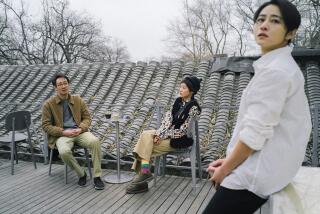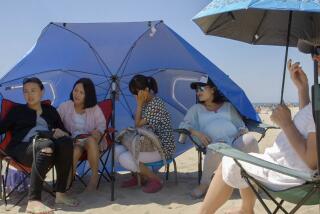China: A nation’s spirit felt in Nanjing
NANJING, China — I approached Nanjing on a bullet train from Shanghai, just 160 miles away, watching the weirdly empty countryside whip past my window.
The world’s most populous nation seemed to be missing a billion or so people.
A digital panel inside the cabin showed our speed at nearly 190 mph. I couldn’t feel a thing except keen disappointment that America seemed incapable of building a rail system this efficient and comfortable.
An attendant in a crisp blue uniform appeared, offering me coffee and a packet of dried peas. Overhead a soothing voice purred, “Welcome to Harmony Express. We thank you for your patience and support.”
No, no, thank you!
All too soon we glided into the station, and the soothing voice abruptly ordered me out.
Nanjing was a sharp, exhilarating slap in the face. The sprawling city of 8 million rises from the banks of the mighty Yangtze River, spreading toward mountains that coil around it like a dragon.
Skyscrapers spiraled upward from every quarter. Thousands of stately plane trees formed luxurious canopies above chaotic streets. Canals and tributaries meandered through cramped neighborhoods.
My taxi crept through hellish traffic, nearly clipping an old woman on a bicycle carrying hundreds of pink Hello Kitty balloons.
“Close,” the driver said with a grin.
Nanjing, capital of six imperial dynasties dating back nearly 2,500 years, has played a central role in the great pageant of Chinese history and endured some of its worst traumas, including the infamous massacre by Japanese troops in 1937. Over the centuries, it’s been razed and rebuilt and razed again.
Perhaps that’s why it radiates a somber grandness far different from the gleeful commercial mayhem of Shanghai or the political intrigue of Beijing.
Like many first-time visitors to China, I was both entranced and baffled by the nation. I thought if there was one place to gain perspective on the intimidating breadth of China and its history, Nanjing was it. And the city was an easy two-hour trip from Shanghai.
I began at the vast Nanjing Museum, one of the oldest and finest in the country with more than 420,000 artifacts scattered across 17 acres of pavilions, halls and beautifully landscaped gardens.
The sign near the entrance told me I was in the right place.
“Due to its geographical advantages and rich culture this city is regarded as the witness of the history of China and was its first capital in 229 AD … The strategic state of Nanjing was just the same as Rome of Western civilization.”
Nanjing’s recorded history dates to 475 BC. It became capital of the Kingdom of Wu in AD 229 , capital of the Ming dynasty in 1368 and seat of the Republic of China in 1912.
Nanjing’s prominence made it vulnerable to invaders and rebels.
In 1850, a zealot named Hong Xiuquan claimed to be the brother of Jesus and launched the Taiping Rebellion that cost a staggering 20 million lives, arguably the bloodiest civil war in history. He made Nanjing his capital, and by the time it was retaken, 100,000 residents were dead and the city was in ruins.
But war didn’t define Nanjing. The museum highlights the cultural life of the city with porcelain vases from the Ming dynasty, jade doorways from ancient temples and finely carved Taoist and Buddhist deities.
Lurking in a small bamboo forest outside were life-size statues of monks singing and playing the lute. Elderly couples — real ones, not statues — practiced tai chi nearby.
After a few hours, I left the museum and took a taxi up Purple Mountain to enjoy the rest of a crisp November day.
Purple Mountain is the great playground of Nanjing, a huge swath of forest and trails where 35,000 plum trees explode with pink and burgundy blooms every year.
I dodged boys flying kites and headed up the Sacred Way, a winding path lined with huge stone elephants, camels, lions and horses leading to the mausoleum of Emperor Zhu Yuanzhang, founder of the Ming dynasty. Hundreds of people jammed the path, snapping photos of autumn trees aflame in red and gold.
I retreated farther up the mountain to the mausoleum of Sun Yat-sen, who founded the Republic of China here in 1912 and is considered the father of modern China.
The memorial is atop a very steep set of stairs with a marble statue of Sun inside.
From the top, the true scale of Nanjing can be taken in. The mountains spread down to the 600-year-old city walls before petering out in a sea of urban congestion.
As darkness fell, I returned to my room at the Nanjing Central Hotel, an eccentric place where a willowy woman in a white dress played Elvis songs on a baby grand piano.
The dinner buffet was magical.
Imagine a Chinese Sizzler but instead of steak and mashed potatoes, there was salted duck, frog balls (tiny globes of frog meat) and two-kinds-of-fungus soup. Oh, and all the beer you could drink.
I stumbled hypnotically through the exotic plenty, entranced by the sensor-controlled lids on the food trays that rose in silent tribute whenever I approached.
After several trips to the buffet and beer station, I slowly made for the street and caught a cab to the Temple of Confucius.
The temple, dedicated to China’s greatest sage, stands near the Qinhuai River and marks the center of Nanjing’s bustling market area, a warren of narrow alleys where everything from silk to mackerel-on-a-stick is sold.
After a day spent immersed in Nanjing’s daunting past, reveling in its vibrant present was a welcome relief.
I drank a cup of tea beside the river and watched the colorful boats slip by. Moonlight fell on the water, red lanterns swung in the evening breeze. Throngs of young people strolled over a neon-lighted bridge. Standing tall in the nearby temple, a marble Confucius smiled down on us.
But the past was never far away.
The next morning brought me to the Nanjing Massacre Memorial Hall, a vivid depiction of the atrocities committed by the Japanese army after it invaded China and captured the city on Dec. 13, 1937.
A 40-foot-high sculpture of a woman carrying a dead baby, titled “Family Ruined,” stood outside.
“Never returns the son killed. Never returns the husband buried alive. Sorrow drowns the wife raped. Heavens!” read the inscription.
The museum chronicles the six-week orgy of violence that became known as the Rape of Nanking, as the city was once called. Given that more than 300,000 people were slaughtered, the museum is fairly restrained. But polemics and hyperbole are unnecessary when facts alone are so damning.
Inside are floor-to-ceiling photos of Chinese civilians used for bayonet practice. Laughing Japanese soldiers behead prisoners; others are buried alive. A small boy is tied to a tree awaiting decapitation for selling candy. Women are shown mutilated. Everything is translated into English and, of course, Japanese.
Mass graves with thousands of bones also can be found inside. I rounded a corner and bumped into a knot of elderly men looking at a photo of a naked woman and a grinning Japanese soldier. Her face is a mask of dread and despair.
“See that?” one asked me in broken English. “Every Japanese should see that.”
The fact that some Japanese deny or downplay the massacre remains a major irritant in relations between the two nations.
Still, there were heroes. I came across a statue of American missionary Minnie Vautrin, who saved 9,000 Chinese women at the Ginling Girls College in Nanjing.
There was a tribute to John Rabe, a German businessman who set up the Nanking Safety Zone and rescued 200,000 Chinese.
“History must never be forgotten. The Nanjing Massacre is a true tragedy for the Chinese nation, a natural humiliation. … It should forever be inscribed in Nanjing’s memory,” said a sign near the exit.
I came to Nanjing searching for insights into China through its history and now felt crushed beneath its weight.
Yet all around me life continued as it had for millenniums. Incense still burned in the temples. Old men still played lutes on Purple Mountain. Ships still plied the Yangtze.
And perhaps that was it. War, tyranny and suffering ebb and flow, but it is the resilience of a people that defines a nation.
More to Read
Sign up for The Wild
We’ll help you find the best places to hike, bike and run, as well as the perfect silent spots for meditation and yoga.
You may occasionally receive promotional content from the Los Angeles Times.






